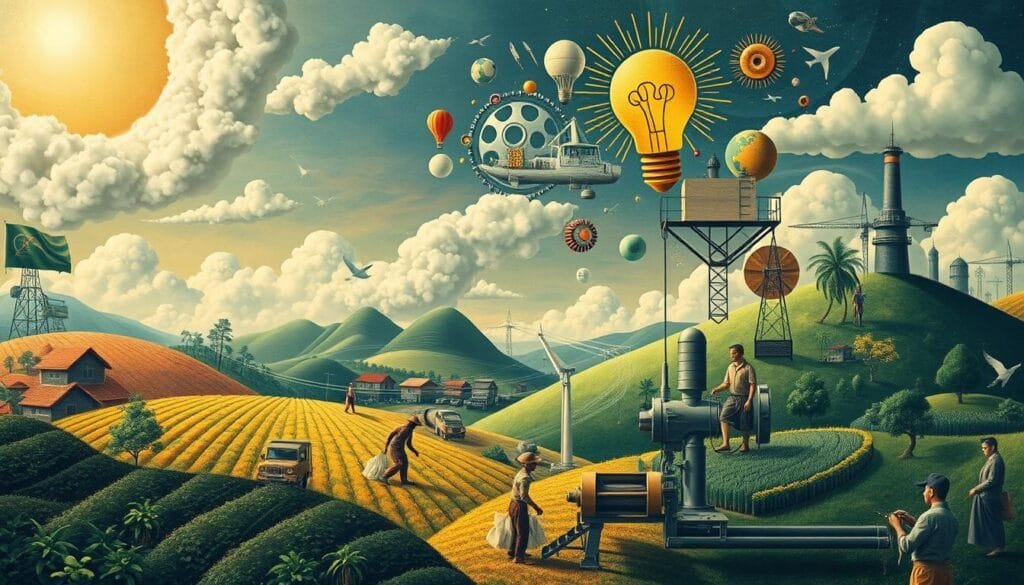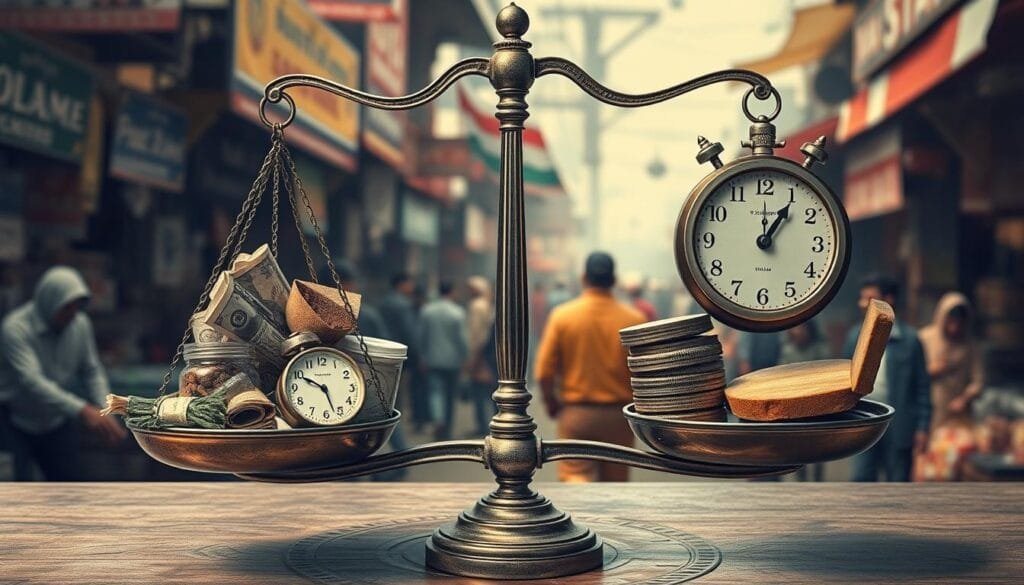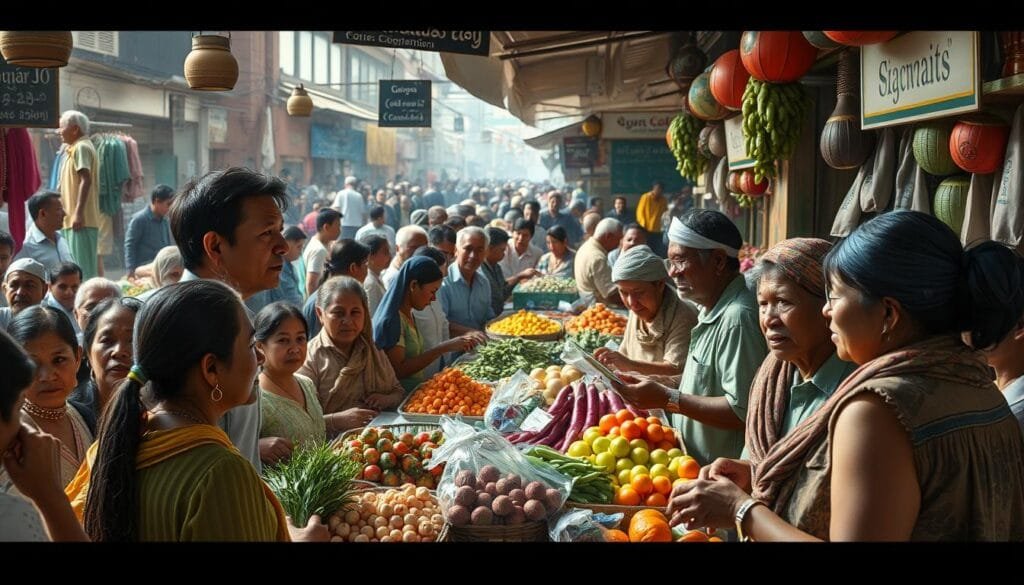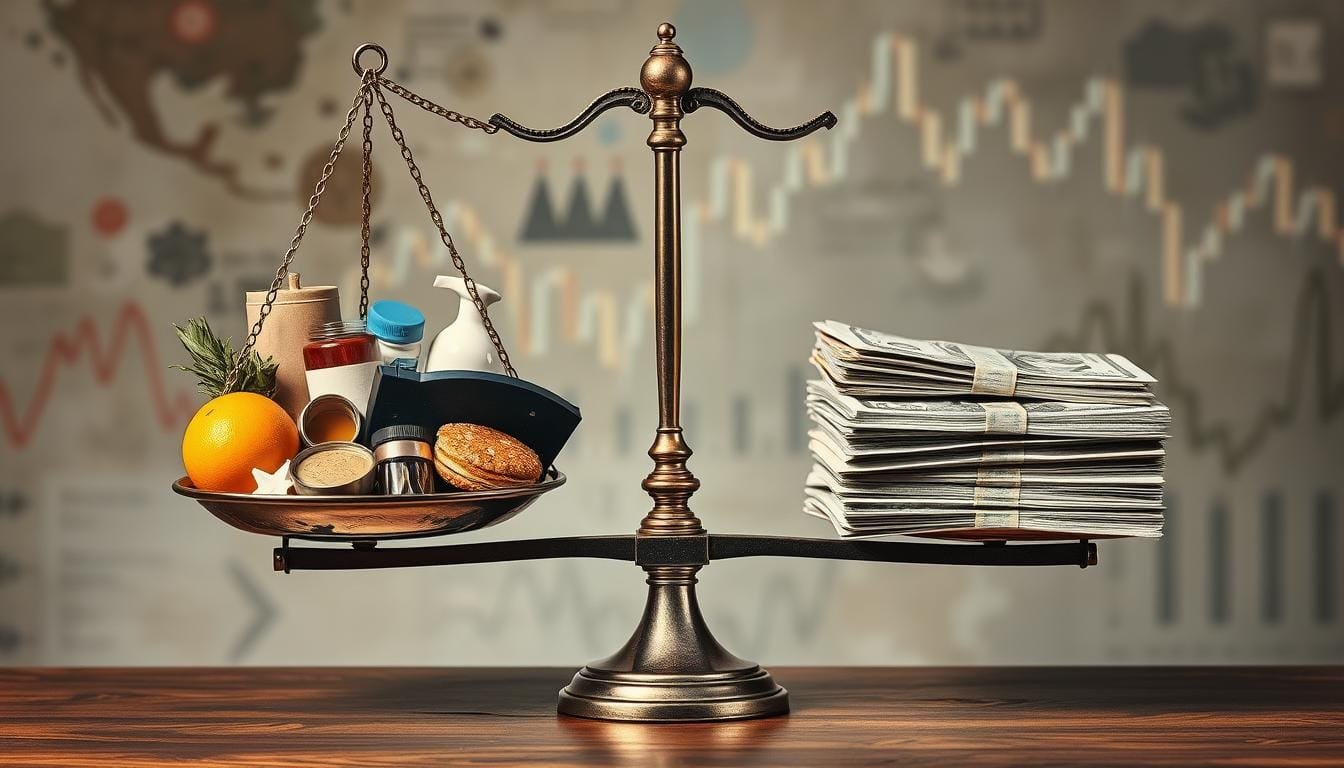Ever wondered why picking one job over another might mean missing out on more schooling? Economic trade-offs are key in making decisions that impact people, businesses, and governments. They help us understand how to best use our limited resources in daily life and in big economic decisions.
At its core, a trade-off in economics means giving up one thing to get another because our resources are finite. This concept is real and something we deal with all the time. It could be a shopper choosing between two items, a company figuring out what products to make, or a government deciding how to spend its budget. By grasping these trade-offs, we make smarter choices and use our resources wisely.
Let’s dive into the complexities of trade-offs and their role in our economy. We’ll look at real examples and the principles behind these essential decisions. To understand more, read about economic trade-offs and why they matter in our lives.
Key Takeaways
- Economic trade-offs require choosing between different options because our resources aren’t unlimited.
- These choices are crucial for the decisions of shoppers, companies, and governments.
- Understanding these trade-offs leads to better resource use and more efficiency in the economy.
- The idea of opportunity cost is closely linked to trade-offs, showing the value of the next best option we give up.
- Examples from the real world show how trade-offs affect different economic players and sectors.
What Are Trade-Offs in Economics?
Trade-offs in economics involve choosing one thing over another because resources are limited. This helps us handle economic challenges better.
Definition and Concept
Economic trade-offs mean making choices always involves giving something up. This idea is key in economics as it shows people and groups have to decide what’s most important. For example, a student with only $12 might have to choose between going bowling, buying toys, eating out, or seeing a movie. Each choice stops them from doing something else.
Real-Life Examples
Here are some examples of trade-offs:
- A family decides between buying groceries or saving for a vacation, showing economic limits.
- Companies might choose between getting new tech or hiring more workers to boost work output.
- Government decisions might include choosing between helping people with social programs or building new roads for everyone’s benefit.
An economics class gives each student $12 to spend in a simulation:
| Activity | Cost |
|---|---|
| Bowling | $4.00 |
| Toys | $4.00 |
| Restaurant lunch | $2.00 |
| Amusement Arcade | $5.00 |
| Candy | $1.00 |
| Movies | $5.00 |
This simulation shows students must pick what they’ll do with their money, showing the real sacrifices in economic choices. Choosing a movie, for example, means they can’t buy toys or have lunch out. This helps understand the trade-offs in our decisions.
Causes of Trade-Offs
The main reason for trade-offs is scarcity. We want more than we can have. People, companies, and governments pick how to use what little they have. These choices show trade-offs are everywhere in economics.

Unlimited Wants vs Limited Resources
We all want a lot, but there’s not enough to go around. This leads to trade-offs. For example, we choose between buying things now or investing for later.
Specializing helps us use what we have better. It’s why countries make what they’re good at. This makes trade-offs part of making and buying things.
Economic Agents and Resource Allocation
How people spread out resources affects everything. It influences happiness and how the economy grows. People who want things now rather than later show a trade-off in saving or spending.
Choosing a car size mixes safety with how much gas it uses. Countries face choices, like keeping prices stable or growing the economy. The Phillips Curve shows how hard it is to have both low unemployment and inflation.
Looking at these trade-offs helps us understand decisions in shopping, policy, and trade. It shows us why and how choices are made in economics.
Importance of Trade-Offs
Understanding trade-offs helps us make better choices in economics. It’s about knowing what’s more important to focus on. This way, we can use what we have wisely and get the best results. Knowing about trade-offs also helps with big plans and making rules that affect our economy.
Decision-Making Process
Trade-offs are key when we decide how to use limited resources. Take the “guns versus butter” idea. It shows the tough choices between defense and civilian needs. There’s also the production-possibilities frontier (PPF). The PPF teaches us about choosing how to spend our resources and what we give up by those choices.
Without considering trade-offs, our choices might not be the best. This can lead to missed chances for better results.
Impact on Resource Management
Trade-offs are essential in managing what we have. They show us what we give up when we choose one thing over another. For instance, businesses have to weigh the risks and rewards of their investments. They also need to decide which projects are worth the effort and money.
Ignoring trade-offs can make it hard to decide anything. But, facing these choices head on makes sure we use our resources well. This leads to lasting growth and new ideas.
| Scenario | Trade-Off | Opportunity Cost |
|---|---|---|
| Military vs. Civilian Goods | Choosing defense spending over social programs | Reduced funding for healthcare or education |
| Business Investment | High-risk vs. low-risk investments | Potential foregone returns from safer investments |
| Government Policy | Expansionary policies to boost GDP | Increased inflation rates |
What is Trade-Off in Economics
In economics, a trade-off means choosing one thing over another due to limited resources like time or money. This decision-making involves sacrificing one aim to reach another. It’s key to how we make economic choices.
Economists look at trade-offs between being efficient and fair. They think about how laws like progressive taxes and redistribution work.

Opportunity Cost Explained
Opportunity cost is what you give up when you choose one option over another. It plays a big role in economic decisions. It’s found by subtracting the cost of the next best choice from the chosen one:
\( Opportunity Cost = Cost of Chosen Alternative – Cost of Next Best Alternative \)
For example, spending on education means not investing that money elsewhere. This shows the trade-off and what is lost when we prioritize one goal over others. Learn more.
Trade-Offs vs Opportunity Cost
Trade-offs are the choices we make, while opportunity costs are the hidden costs of those decisions. We face different trade-offs with our time, money, and resources. These include how we split time between work and fun or choose what to buy.
These concepts play a huge role in the real world. They help us evaluate risks, analyze costs and benefits, and manage resources. Take the decision to go to law school, for example. The opportunity cost here includes earnings and savings lost, plus any debt gained. Understanding these ideas lets us make smarter choices and see what we give up in our decisions.
Examples of Trade-Offs in Different Sectors
Trade-offs are a big deal in all areas of the economy. They affect everything from what we buy to major company strategies and government rules. Making choices on how to use resources or plan economically always involves trade-offs.

Consumer Choices
People often choose between spending now and saving for later. For example, most American families save about 30% of their money. This shows a common trade-off in consumer behavior. Every saved dollar is one less for buying things now. Also, picking between relaxing or working more to earn extra money can make a big difference in happiness, depending on the situation.
Business Decisions
Trade-offs in business shape important strategies. Firms might invest in new tech or stick with what they have. For instance, using eco-friendly methods can make operations 20% more expensive. This affects profits in the short run. Choosing speed over quality in making things can lower quality by 25%. Picking investments is another area. Riskier stocks might bring in 7-10% a year, unlike safer bonds that return only 2-3%.
Government Policies
Trade-offs are clear in government economics too, especially in policy-making. The “guns or butter” model shows choosing between defense spending or civilian goods. Spending more on public services like health or education might mean higher taxes. Tax rates in such countries are usually between 25-50%. Also, having laws for mandatory vaccinations to achieve herd immunity involves weighing personal freedom against the health of the community.
| Sector | Trade-Off Scenario | Data/Statistics |
|---|---|---|
| Consumer Choices | Savings vs. Consumption | 30% allocated to savings vs. current consumption |
| Business Decisions | Sustainability vs. Operational Costs | 20% increase in costs for sustainable practices |
| Government Policies | Military vs. Civilian Goods | Tax rates 25-50% for public goods investment |
Evaluating Trade-Offs
Evaluating trade-offs means looking at the cost-benefit analysis of different choices. We do this to find the best result based on what we give up. This is key in economics because we have limited resources and need to decide what’s most important.
Every choice has an opportunity cost. This cost is what we give up by choosing one option over another. For example, when saving money, we decide not to spend it right away. Governments also face tough decisions like spreading funds across education, health, and roads.
Our daily choices involve trade-offs, like finding time for exercise or choosing between risks and rewards in business. Making smart trade-offs can lead to growth and sustainability. Sometimes, short-term benefits may harm the environment in the long term.
It’s crucial to use decision-making techniques that consider all costs, whether seen or unseen. The “guns versus butter” model shows how we must choose between military and civilian spending. The production-possibilities frontier (PPF) shows the maximum we can achieve with what we have. Bringing diverse minds together can make these choices clearer and more effective.
Recent studies highlight the importance of Trade-off Analysis (TOA) in agriculture. Most research looked at profit, yield, and water use. These findings stress the need for thorough decision-making for sustainable results.
Conclusion
As we wrap up our journey through economic trade-offs, we see its importance in making smart decisions. Knowing that resources are limited while wants are endless is key. This idea is crucial for both individuals and economies.
We’ve learned that thinking carefully about trade-offs can help us get the most satisfaction. Every choice has a cost, showing us what we give up. This knowledge lets us set priorities and use resources wisely.
The work of Franco Modigliani and Merton Miller in 1958 started us off. Since then, we’ve seen how trade-offs shape choices, from government budgets to personal spending. Understanding trade-offs is vital for creating plans that boost growth and productivity. It enables us to choose wisely, considering our goals and what we have.
FAQ
What are economic trade-offs?
Economic trade-offs make us pick between scarce resources. Choosing one option means giving up others. This choice is key in economics, for making decisions and allocating resources.
Can you give some real-life examples of trade-offs?
Sure! An example is a company investing in tech but reducing employee perks. Or, choosing between a vacation or saving for retirement. These show how trade-offs affect daily life.
Why do trade-offs occur in economics?
They happen because we have limitless wants but limited resources. This scarcity makes us choose how to use our resources wisely among many options.
How does the decision-making process involve trade-offs?
Making decisions means looking at options and their pros and cons. We face trade-offs when we miss out on one benefit to gain another. This affects how we manage resources and plan.
What is opportunity cost, and how does it relate to trade-offs?
Opportunity cost is what we lose when we choose one option over another. It’s tied to trade-offs, showing us the cost of our choices and what we give up.
How do trade-offs affect consumer choices?
Trade-offs are big in shaping what consumers buy. When picking one product over another, they weigh the good and bad. This decision reflects their wants and financial situation.
What role do trade-offs play in business decisions?
In business, making choices involves weighing different paths. For instance, choosing between new products or marketing. This requires looking at potential gains and costs, guiding key company decisions.
How do government policies involve trade-offs?
Governments face trade-offs in policy-making. Spending more on healthcare might cut funds for education or roads. These choices weigh society’s benefits and costs to meet economic goals.
How do we evaluate trade-offs?
We use cost-benefit analysis and decision methods to assess trade-offs. By comparing benefits and costs of various choices, we make decisions that fit our economic aims and resource plans.
